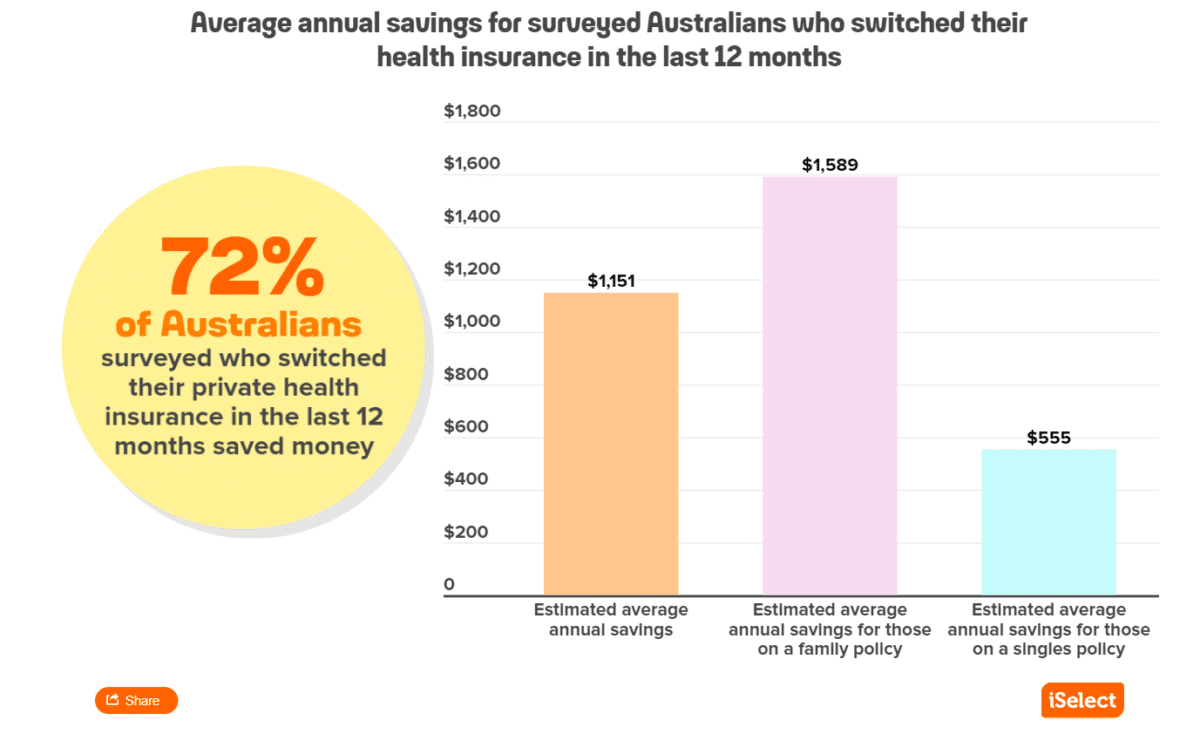
Loyalty is a virtue. But is blind loyalty costing you savings?
New research conducted by iSelect as part of their 2024 Health Pulse survey found that Australian women, on average, have been with their current health provider for 8.2 years.
To put that into perspective, eight years ago, Malcolm Turnbull was our Prime Minister. The average cost of petrol was $1.10 a litre, and we watched on as the UK held its Brexit referendum. It’s fair to say a lot has changed in eight years’ time.
While there’s nothing wrong with sticking with a good thing – which appropriate health insurance no doubt is – setting and forgetting can have consequences, including the financial type. I get it; we’re all busy. The idea of taking time out of your day to check on your health insurance may seem like more effort than it’s worth. That is until you realise iSelect’s survey also discovered that 72% of people who switched their health insurance in the last 12 months saved money. The average annual saving was a satisfying $1,151.
Why are women sticking with the same private health insurer?
With kids, jobs, and life admin all fighting to be front and centre of our brains, it’s understandable that Australian women can only think about their health insurance long enough to pay for it. What may be taken as loyalty to a health insurer could simply be a case of not having enough time to find an option that better suits them (and their families).
What are Australian women looking for in their health insurance?
When asked why they chose to switch health insurance, surveyed Australians had two top reasons: they wanted better value and a cheaper deal. Given the cost-of-living crisis appears to have no end in sight, those are incredibly understandable and relatable motivations. But what does better value actually mean?
Well, for the surveyed Australian women, there was a clear consensus for which three extras were the most important. General dental, optical, and major dental coverage were priorities for more than half of the women surveyed. Medicare doesn’t typically cover these services, so people will often opt for private health insurance to help with what can be some expensive bills.
These services can be particularly meaningful for women on family policies.
Dental disease can have widespread impacts on a child’s health and well-being, now and well into the future. Kids aged five to nine, unfortunately, have the dubious honour of the highest rate of potentially preventable hospitalisations due to dental conditions when compared to other Australian age groups.
Anecdotally, we’ve all heard of at least one child’s misbehaviour or lack of interest in class suddenly being rectified with a pair of glasses and the ability to see the whiteboard.
So, how much can women expect to save by switching health insurance?
While the Health Pulse survey did reveal Australians, on average, saved $1,151, the numbers aren’t quite the same when split by gender.
On average, women only saved $869, compared to men who saved $1,379 on average.

Importantly, health insurance is community-rated. This means that, unlike other types of insurance, gender doesn’t affect premiums. Women and men pay the same premium for the same policy.
So, why the discrepancy in savings? According to iSelect’s Andres Gutierrez, Health General Manager, it could be down to the coverage different genders are selecting.
“If women are after a policy that covers them for pregnancy so that they can choose their obstetrician and give birth in a private hospital, they’ll generally need to pick a gold-tier hospital policy. Gold, obviously, is top of the line, offering the most coverage while also tending to come with a higher premium,” he said.
“While this gold tier policy can certainly be beneficial when you’re looking to start or expand your family, it could also have unnecessary cover if you aren’t planning on having any babies in the near future.”
Sure, no one would be mad about receiving an extra $869 a year, but is it the best women can hope for? Not necessarily. Looking at the data through the lens of a family policy suggests there could be more savings to be had.
According to those surveyed who switched health insurance while on a family policy in the last 12 months, they saved an average of $1,589 annually.

Even how Australians went about switching also appeared to have an effect on their expected annual savings. Those who opted to use a comparison service, on average, saved an extra $200.
How could you save by switching health insurance?
Everyone’s health needs are different. As a result, we all require different things from our health insurance. While one person may need minimal coverage, another may need more services covered. These differences can lead to a wide range of health insurance premiums. However, there are still tips everyone can follow to be a savvy health insurance switcher.
Pick only the cover you need
When looking at health insurance, it can be a good idea to stick to the essentials as best you can. Sure, it can be tempting to be covered for as much as possible, but it may not be necessary for you right here and now. In the future, your health needs may change (they likely will!) and you can always adjust your cover as the time comes. That way, you can avoid paying for things you don’t actually need.
It can be worthwhile to take the time to really think about what you need (or expect to need) over the coming year or two. Maybe this year is the year you finally get back to the dentist? If so, extras that include dental might be on the cards. Alternatively, you might be thinking about expanding your family in the next couple of years. In that case, hospital cover that includes pregnancy may be the order of the day.
Check-in on your health insurance regularly
Loyalty could be responsible for far too many women paying more than they need to for their health insurance, so don’t let it happen to you.
Making time to regularly re-evaluate your health insurance, including what you’re covered for and what you’ve been using, could help you get both value and savings. Remember, what you needed last year or the year before may not be what you need now.
If you’re worried about not having enough time or bandwidth to do a thorough check-up of your policy, comparison services can help. They can quickly help you compare a range of policies from different insurers and see if you could be better off with another option.
Consider the value of covering your kids
While a family or single-parent family policy may mean a higher premium than a 'singles' policy, it does mean you can look after your kids’ health, too. Plus, remember that kids are often free to cover up until a certain age.
It can be a balance between what you pay in premiums and what you get back in value. Paying a little more each month to look after both your and your kids’ well-being could be more than worth the extra cash.
Is it time to find out what you could be saving on health insurance?
Leave blind loyalty to the fairytales. Taking the time to really look at your health insurance – and what else is out there – could be one way you take back some power over the cost-of-living crisis and find some wiggle room in your budget.













